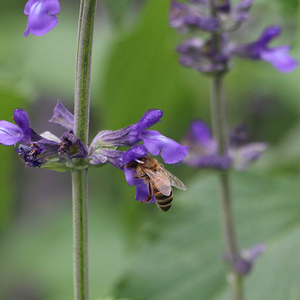This article is part of our first-ever EPIC Impact Journal. For more on this groundbreaking publication and how to get your hands on one, click here.

Outdoor escape is the most liberating and cleansing way to let loose. It’s a reminder there is more to life than screens, air conditioning, and the seemingly endless pull of the internet — a reminder that nature, our lands, and the vibrant organisms around us are what truly matter. It’s a chance to strengthen our bond with the world that has been home to (and fed) our ancestors since the dawn of time. But to secure a healthy, promising future for ourselves and those who come after us, we need to ensure the prosperity of one tiny insect: the bee.
As the chief pollinators of the planet, bees are responsible for fertilizing a jaw-dropping percentage of flowers and crops. Without them, the majority of flowering plant species (including almost every vegetable we eat) could not reproduce and would die off. That includes alfalfa and clover, which are essential food for livestock, like cattle.
To better understand these powerful and vital creatures — especially honeybees — we turned to Tara Chapman of Two Hives Honey. Tara is an absolute pro when it comes to pollinator proliferation and integration into our modern world, and is a key resource for everything from the process of pollination to hive structures to the thousands of different bee species that inhabit our world. Perhaps the most fascinating thing about these insects is how sophisticated and unique they are. “Every hive has a personality. Some build beautiful, straight comb, while others build in crazy shapes and sizes,” Tara said. “Some take their dead and essentially toss them out, but I’ve seen times where they’ve been carried away and lined up with their heads all facing the same direction — almost like a honeybee burial ceremony.”

This is all part of their larger social structure, which harnesses collective power for the greater good of the hive. The concept sounds strange at first, but it allows honeybee hives, whose populations can run anywhere from 45,000-75,000, to run with ruthless precision. Everyone has a specialized role. Male bees (drones), for instance, have one job: reproduce. “They have a singular function, so they’re basically disposable,” Tara joked. “They fly around the hive all day looking for a queen to mate with. As crazy as it sounds, their intestines are literally pulled out of their bodies once they’re finished having sex.”
It does sound crazy, but the point of Tara’s example is that individuality doesn’t exist in the hive. Everyone is a cog in a larger machine — and for it to run harmoniously, every bee must do its job. Scientists refer to bees’ collective social structure as a superorganism: a beautiful, unified unit with a common goal. That’s why individual bees are willing to sting threats to their hives even though doing so kills them. There isn’t a nobler example of sacrifice in the world.

Most people assume the queen is the most powerful bee in the hive, but that’s not exactly true. She’s definitely important — without a queen, a hive goes into a frenzy and can collapse almost immediately — but worker bees are the real champions. “Every bee you’ve seen out and about is a worker bee,” Tara explained. “They’re the ones who are responsible for gathering nectar from plants to create honey within the hive. In the process of going plant to plant, they pollinate our world for us. Without them, nobody would eat in their hives.”
We’d have a hard time eating without them, too. Name a food and, chances are, honeybees have played a role in helping it arrive at your dinner table. From cucumbers to apples to cocoa and coffee, bees are heavily involved in the fertilization processes that help plants create seeds for future generations. They’re also integral to the success of the ranching and dairy industries, ensuring many of the cover crops ruminants eat can flourish every year. And yet, North America’s bee populations have plummeted over the past several decades due to large-scale destruction, deadly pesticides, and commercial agriculture. Suddenly, our once-overlooked food guardians are facing massive population declines and, for many species, extinction.

So much of this stems from Big Ag. As vast fields of monoculture — growing a single commercial crop in mass, like almonds and walnuts — have replaced traditional farms, they’ve demanded an increasingly larger presence of honeybees to pollinate them. To fill this need, these operations import commercial ‘migratory’ hives by the truckload (picture this: an 18-wheeler full of millions of bees) during the growing season. This has proven to be a particularly profitable method, but it has come with dire consequences: it’s killing off the bees. “Just like humans, dietary diversity is crucial for bees. When they’re forced to pollinate giant fields of the same crop, they’re not getting a balanced diet,” Tara said. “Massive monoculture farms, especially those using neonicotinoids, have created a vicious cycle that nobody’s benefiting from.”
Neonicotinoids are a class of especially deadly insecticides. A key ingredient on many monoculture farms, they indiscriminately target the central nervous system of insects and result in paralysis or death — and Big Ag will continue exposing millions of imported bees to them as long as it can turn a profit. But with the help of beekeepers like Tara, and pollinator-conscious companies across the country, we’re fighting back. EPIC is heavily invested in ensuring these creatures play a key role in the food revolution , and we’re actively educating our consumers to increase their bee knowledge and awareness. Additionally, we are dedicated to supporting bee-friendly producers and campaigns. Furthermore, we have installed several hives at ROAM Ranch to accelerate the growth of its biodiversity, help lay a strong foundation for critical plant species and broader land regeneration, and help proliferate sensitive terrestrial ecosystems. All of these factors are essential to our planet’s health and exemplary of the impact bees have on our world. When it’s all set and done, we’ll have over three million honeybees helping ROAM flourish. “For a ranch, if you have your cattle on pasture eating alfalfa and clover, you’re going to need bees out there,” Tara said matter-of-factly. “The biggest animals often rely on the smallest ones.”

The right decision typically isn’t the easiest one. It costs more to do things in ways that positively impact our soil and our animals. But it’s worth it, both in ecological impact and product quality. As a result, we’re working to ensure these striped, six-legged workaholics are more valued, cherished, and recognized than ever before. We need you, the reader, to do the same. So whether it’s putting up a hive in your backyard or supporting your local farmers and ranchers who are pollinator-friendly and avoid pesticides, go the extra mile. Our world, its bees, and future generations will thank you.



